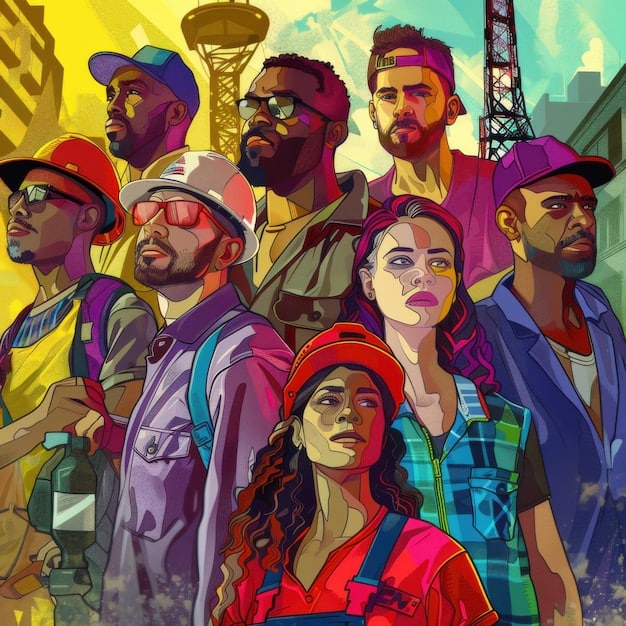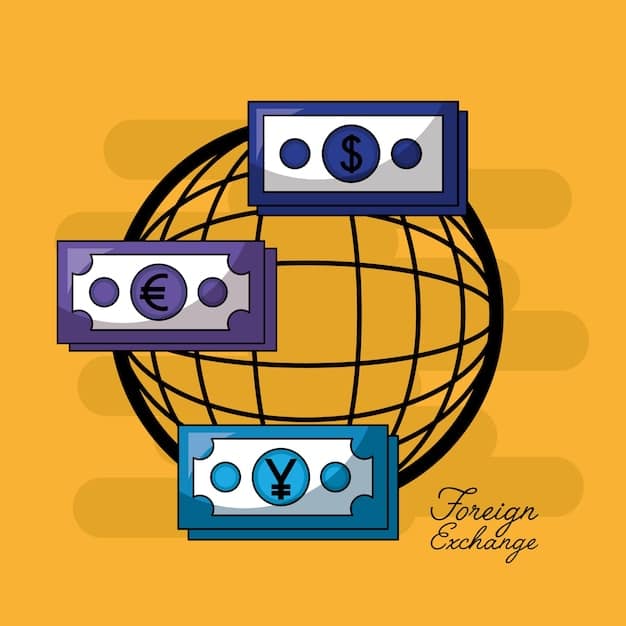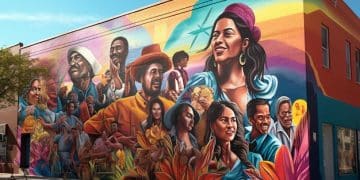The Global Impact of Hip Hop: Culture, Music, and Art Worldwide

The global impact of hip hop underscores its remarkable evolution from an American street culture to a formidable worldwide phenomenon, deeply influencing music, art, fashion, and social movements across diverse geographical landscapes while continuously adapting to local contexts and expressions.
The global ascent of The Global Impact of Hip Hop: How American Culture Is Influencing Music and Art Worldwide is a compelling narrative of cultural diffusion and adaptation, demonstrating an unparalleled capacity to resonate across continents and redefine artistic expression. Its journey from urban American streets to a dominant global force speaks volumes about its inherent universality and its power to connect diverse audiences.
The Genesis and Global Spread of Hip Hop
Hip hop began in the Bronx, New York, during the 1970s, as a grassroots movement born from economic hardship and social inequality. It offered a voice and a creative outlet for marginalized youth. This movement encompassed four foundational elements: DJing, MCing (rapping), breakdancing, and graffiti art, each contributing to a vibrant subculture. The early parties thrown by pioneers like DJ Kool Herc laid the groundwork for what would become a global phenomenon.
The initial spread of hip hop was largely organic, driven by block parties and local community events. However, as independent record labels began to recognize its commercial potential, hip hop music started to reach a wider audience. Early acts like The Sugarhill Gang and Grandmaster Flash and the Furious Five broke through, introducing the genre to mainstream America and, soon after, to the world. Their music, often characterized by its raw energy and narrative focus, resonated with young people seeking something new and authentic.
Early International Adoption
The late 1980s and early 1990s saw hip hop gaining traction in various parts of the world. Countries in Europe, such as France and the UK, were among the first to embrace it. Germany and Japan also developed significant hip hop scenes. This initial wave was often characterized by imitation, with artists mirroring American styles and sounds. However, it quickly evolved as local artists began to infuse their own cultural nuances, languages, and political realities into the genre. This process of localization was crucial for hip hop’s sustained growth outside its birthplace.
The global spread was also aided by early tours and collaborations by American hip hop artists, exposing international audiences to the energy and artistry firsthand. Media outlets, though limited at the time, also played a role in disseminating images and sounds of this burgeoning culture.
* Early adopters included countries like France, the UK, Germany, and Japan.
* Initial influences were primarily direct imitations of American styles.
* Artists soon began to infuse local cultures, languages, and political realities.
* Tours and media helped accelerate its international uptake.
This period marked a critical transition from an American subculture to a globally recognized art form, setting the stage for its deep and pervasive influence across multiple domains. The willingness of artists and audiences worldwide to engage with and adapt hip hop was a testament to its compelling appeal and versatile framework.
Musical Innovation and Adaptation Worldwide
The musical aspect of hip hop, primarily rapping and DJing, has undergone extensive innovation and adaptation across diverse global landscapes. While American hip hop laid the stylistic and thematic groundwork, artists worldwide have meticulously woven in their own musical traditions, linguistic styles, and lyrical concerns, creating a rich tapestry of global hip hop sounds.
One of the most striking aspects of hip hop’s global musical evolution is its fusion with traditional and contemporary local genres. For instance, in West Africa, artists frequently incorporate traditional drumming patterns and highlife melodies into their beats. In India, elements of Bollywood music and folk rhythms blend seamlessly with rap verses. This cross-pollination not only enriches the hip hop sound but also introduces listeners to a broader spectrum of global music.
Linguistic and Lyrical Diversity
Beyond musical styles, language plays a pivotal role in hip hop’s global adaptation. While English remains a strong presence, especially in its origins, artists increasingly rap in their native tongues, reflecting local dialects, slang, and cultural references. This linguistic diversity allows hip hop to connect more profoundly with local audiences, addressing specific social, political, and economic issues pertinent to their communities. For example, French hip hop often features intricate wordplay and philosophical undertones, while German hip hop can be more direct and politically charged.
This emphasis on local narratives and vernaculars has transformed hip hop from a purely American export into a multitude of locally relevant expressions. The lyrical content often shifts from the aspirational themes common in early American hip hop to more introspective or politically active narratives, reflecting unique national struggles and triumphs.
* Artists incorporate local musical traditions like African drumming or Bollywood sounds.
* Global hip hop often features rapping in native languages and local dialects.
* Lyrical content adapts to reflect specific local social and political issues.
This musical and linguistic adaptation demonstrates hip hop’s remarkable malleability, allowing it to serve as a powerful medium for self-expression and cultural identity across the globe. The continuous evolution ensures its relevance and vibrancy in an ever-changing global music scene.
The Influence of Hip Hop on Global Art and Fashion
Hip hop’s influence extends far beyond music, profoundly shaping global art and fashion landscapes. Its aesthetic, largely born from its urban roots, has become a significant force, influencing everything from high fashion runways to street art murals in cities worldwide.
Graffiti art, one of the original four elements of hip hop, serves as a prime example of this artistic diffusion. What began as an underground form of expression on subway trains and city walls has evolved into a recognized art form, adorning galleries and public spaces globally. Artists from Tokyo to São Paulo have adopted and adapted graffiti techniques, often infusing them with local visual traditions and narratives. This art form provides a platform for social commentary and community expression, mirroring its origins in New York.
Fashion as Identity and Expression
Fashion within hip hop culture is perhaps its most visible and commercially impactful global influence. From oversized tracksuits and sportswear to elaborate jewelry and designer brands, hip hop fashion has consistently challenged conventional norms and set trends. Early on, American brands like Tommy Hilfiger and FUBU gained immense popularity through their association with hip hop artists. Today, this influence is evident in luxury brands collaborating with rappers and in the pervasive casual-chic aesthetic found in global street style.
This influence isn’t merely about wearing certain brands; it’s about using clothing as a statement of identity, status, and affiliation. Globally, young people adopt hip hop fashion as a form of self-expression, often blending it with their own traditional attire or local trends. This synthesis creates unique fashion subcultures that reflect both the global nature of hip hop and the distinctiveness of local identities.
* Graffiti art, originating from hip hop, is now globally recognized and adapted.
* Hip hop fashion influences global street style and high fashion.
* Clothing serves as a key medium for identity and self-expression.
The symbiotic relationship between hip hop’s artistic forms and fashion trends highlights its comprehensive cultural footprint. It’s a testament to how an art movement can transcend its initial boundaries to become a powerful global aesthetic.

Social Commentary and Activism Through Hip Hop
From its inception, hip hop has served as a powerful vehicle for social commentary and activism, providing a voice for the voiceless and shedding light on systemic injustices. This function has resonated deeply across borders, as global artists use the genre to address issues specific to their own societies, often finding common ground with the original struggles depicted in American hip hop.
Much like its American counterpart, which often tackled themes of poverty, racial discrimination, and police brutality, international hip hop artists use their lyrics to expose local socio-political realities. In countries experiencing political unrest or economic disparity, hip hop tracks become anthems of resistance. For example, artists in the Middle East have used rap to critique autocratic regimes and advocate for human rights, while those in Latin America have voiced concerns about corruption and inequality.
Building Bridges and Fostering Dialogue
Beyond direct protest, hip hop fosters dialogue and builds bridges between communities. It allows artists to share narratives of displacement, migration, and cultural resilience. This storytelling serves as both a source of empowerment for those directly affected and an educational tool for broader audiences. Hip hop festivals and concerts worldwide often become spaces for solidarity and collective action, uniting diverse groups under shared causes expressed through rhythm and rhyme.
The global sharing of these narratives also promotes a sense of global citizenship and understanding. When a listener in Sweden hears a track from a Senegalese artist detailing struggles similar to their own, it creates empathy and connection, demonstrating how hip hop transcends geographical and cultural divides to address universal human experiences.
* Hip hop serves as a platform to address social injustices and political issues globally.
* Artists worldwide use lyrics to comment on local realities, paralleling American themes.
* Hip hop fosters dialogue and solidarity, uniting diverse communities over shared concerns.
The genre’s steadfast commitment to truth-telling and advocacy ensures its continued relevance as a tool for social change. It offers a unique lens through which to understand global issues and serves as a rallying cry for collective action, amplifying voices that might otherwise remain unheard.
Hip Hop’s Influence on Language and Communication
Hip hop has profoundly influenced language and communication, not just within specific communities but across global linguistic landscapes. Its innovative use of slang, poetic structures, and narrative delivery has permeated everyday speech, media, and even academic discourse, shaping how people communicate and express themselves.
At its core, hip hop introduced new linguistic styles, creating a dynamic interplay between spoken word and rhythm. The clever wordplay, intricate rhymes, and storytelling techniques employed by MCs have inspired a generation of writers, poets, and public speakers. This linguistic creativity transcends the music itself, manifesting in popular culture through catchphrases, terms, and expressive idioms that have become universally recognized, regardless of origin.
Slang, Accent, and Global Reach
The global proliferation of hip hop means that American street slang and urban dialects have gained international recognition. Words and phrases originating from specific neighborhoods in the US are now understood and sometimes adopted by youth in Paris, Berlin, or Tokyo. This linguistic diffusion creates a shared lexicon, fostering cross-cultural understanding, even as local versions of hip hop introduce their own unique slang and accents.
Furthermore, hip hop has influenced modes of communication beyond simple vocabulary. The direct, often confrontational, yet deeply personal storytelling approach found in rap lyrics has encouraged a more raw and authentic form of expression. This has impacted various media, from film scripts to advertising campaigns, which often emulate the narrative cadence and rhythm inherent in hip hop to connect with younger, diverse audiences.
* Hip hop introduced innovative linguistic styles, influencing poetry and public speaking.
* American hip hop slang has gained global recognition and adoption.
* The genre encourages direct and authentic forms of communication across media.
This linguistic impact underscores hip hop’s role as a pervasive cultural force, continuously reshaping verbal and narrative conventions across the globe. It demonstrates how a musical genre can become a powerful agent of linguistic change and cultural exchange.
The Commercialization and Commodification of Hip Hop
The immense global popularity of hip hop has inevitably led to its significant commercialization and commodification, transforming it from a grassroots movement into a multi-billion-dollar industry. This transition has brought both unprecedented opportunities and considerable challenges, raising questions about authenticity, cultural appropriation, and artistic integrity within the genre.
The commercial appeal of American hip hop artists, their music, fashion, and lifestyle, has created a global market for related products and services. From major record labels investing heavily in rap artists to fashion brands leveraging hip hop aesthetics, the genre has become a powerful economic engine. Endorsements by rappers shape consumer trends, movie soundtracks feature hip hop anthems, and even video games incorporate elements of hip hop culture, all contributing to its pervasive commercial presence.
Global Market Absorption and Local Responses
As hip hop spread globally, local industries recognized its commercial potential within their own markets. This led to the rise of regional record labels, hip hop specific clothing lines, and localized media platforms dedicated to the genre. While this fostered economic growth and supported local artists, it also sometimes led to debates about artistic purity versus commercial success. Some argue that the drive for mainstream appeal can dilute the raw, rebellious spirit that defined early hip hop.
Moreover, the commodification has sparked discussions around cultural appropriation, particularly when non-marginalized groups adopt hip hop elements for commercial gain without acknowledging its origins or contributing to the communities from which it emerged. This tension highlights the ongoing struggle to balance commercial viability with cultural responsibility.
* Hip hop transitioned into a multi-billion-dollar industry, driven by global appeal.
* It functions as a powerful economic engine, influencing various commercial sectors.
* Global market absorption has sparked debates about authenticity versus commercialism.
The commercial journey of hip hop is a complex one, reflecting its journey from underground authenticity to global market dominance. This ongoing evolution demands a nuanced understanding of its economic impact alongside its cultural significance.

The Future of Hip Hop: Hybridization and Continued Evolution
Looking ahead, the future of hip hop appears characterized by continued hybridization and dynamic evolution, solidifying its place as a truly global and adaptable cultural force. Its capacity to absorb and reinterpret diverse influences ensures its ongoing relevance and innovation.
One clear trajectory is the increasing fusion of hip hop with an even wider array of musical genres from around the world. We can expect more seamless blends with traditional Asian folk, African highlife, Latin American cumbia, and European electronic music. This musical hybridization will not only expand hip hop’s sonic palette but also introduce new fan bases to previously unfamiliar sounds, fostering deeper global musical interconnectedness.
Technological Integration and New Platforms
Technology will undoubtedly play a crucial role in hip hop’s future evolution. The rise of AI in music production, virtual reality concerts, and blockchain-based platforms will open new avenues for creation, distribution, and fan engagement. These advancements could empower indie artists globally, providing them with tools to produce and disseminate their work more effectively, potentially decentralizing the industry further.
Furthermore, hip hop’s influence is likely to persist and grow in other cultural spheres. We might see its philosophies and aesthetics informing new forms of interactive art, digital fashion, and even urban planning. Its core tenets of self-expression, resilience, and community will continue to resonate, adapting to new challenges and inspiring future generations across diverse social and political landscapes. The conversation sparked by the genre will continue to evolve, engaging with contemporary issues and shaping public discourse.
* Future hip hop will feature increased fusion with diverse global musical genres.
* Technology will drive innovation in production, distribution, and fan engagement.
* Hip hop’s influence will expand into new cultural spheres like digital art and urban planning.
The trajectory of hip hop points towards an ever more inclusive and innovative cultural domain, continually reinventing itself while retaining its foundational spirit. Its global impact is not merely a phenomenon of the past or present, but a dynamic, unfolding narrative set to shape the future of culture itself.
| Key Aspect | Brief Description |
|---|---|
| 🌍 Global Reach | Hip hop transformed from a Bronx subculture to a worldwide phenomenon, influencing diverse countries. |
| 🎶 Musical Fusion | It adapted globally by incorporating local musical styles, languages, and lyrical themes. |
| 🎨 Art & Fashion | Graffiti art and clothing trends originating from hip hop profoundly influenced global aesthetics. |
| 🗣️ Social Impact | Used globally as a platform for social commentary, activism, and community building. |
Frequently Asked Questions About Hip Hop’s Global Influence
▼
Hip hop originated in the 1970s in the South Bronx, New York, among marginalized youth. Its initial goals were to provide a creative outlet and a voice for communities facing economic hardship and social disenfranchisement. It began as block parties and evolved into a movement encompassing DJing, MCing, breakdancing, and graffiti art, offering a platform for self-expression and community building amidst adversity.
▼
Globally, hip hop has adapted through musical fusion, incorporating local sounds like traditional African drumming or Bollywood rhythms. Lyrically, artists rap in native languages, addressing local social, political, and economic issues unique to their regions. This cultural tailoring has allowed hip hop to resonate deeply with diverse audiences, forming unique localized expressions while retaining its core spirit.
▼
Hip hop has profoundly influenced global fashion, shifting from sportswear and street clothes to high fashion collaborations. It popularized oversized apparel, specific brands, and elaborate jewelry. This influence extends beyond mere clothing to a mode of self-expression and identity, with young people globally blending hip hop aesthetics with local styles to create unique fashion statements.
▼
Hip hop serves as a crucial vehicle for social commentary and activism globally. Artists use their lyrics to expose local injustices, protest political issues, and advocate for human rights, mirroring the genre’s origins in addressing American systemic problems. It also fosters dialogue and solidarity, uniting communities through shared narratives of struggle and resilience, creating a platform for collective action.
▼
Hip hop has transformed into a multi-billion-dollar global industry, primarily through music sales, tours, and powerful branding. Its commercial appeal influences fashion, advertising, and entertainment sectors, leading to significant investments from major labels and brands worldwide. This economic engine, while offering opportunities, also sparks debates about authenticity, cultural appropriation, and the balance between artistic integrity and commercial success within the genre.
Conclusion
The global journey of hip hop from a specific American urban phenomenon to a universally recognized cultural force is a testament to its enduring power and adaptability. It has transcended geographical and linguistic barriers, proving its capacity to resonate with diverse populations by offering a platform for self-expression, social commentary, and artistic innovation. As it continues to evolve and hybridize, hip hop remains a compelling example of how cultural exports can deeply influence and be influenced by global contexts, ensuring its continued relevance and impact on the world stage.





